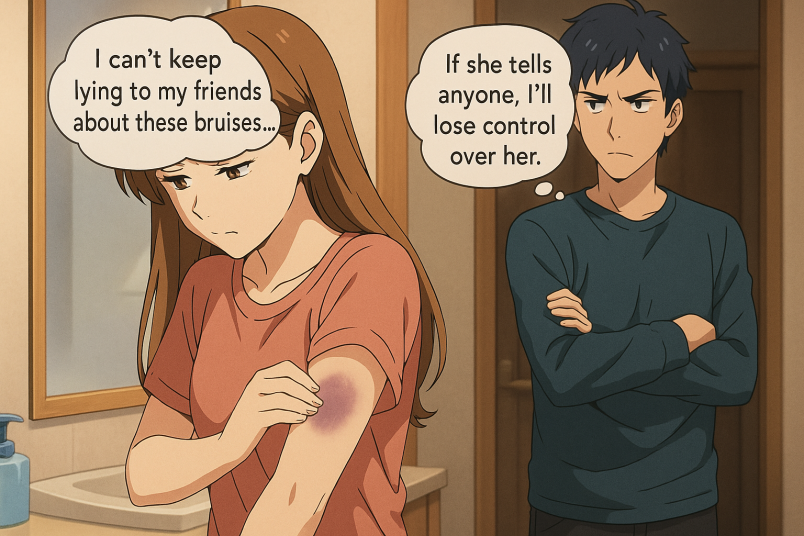7 Facts About Physical Abuse in a Relationship

Unlock Daily 30-Sec Tips for a Happier Relationship
👉 Subscribe FREEKey Takeaways
Marriage.com AI Quick Summary
It’s not always easy to talk about the hurt that comes from someone you once trusted. Love should feel safe, comforting, and real… yet sometimes, it gets tangled with fear and pain.
You might wonder, “How could someone who says they care act this way?”
The truth is, many people hide their struggles, hoping things will change, while quietly carrying bruises—both on the body and in the heart. Physical abuse in a relationship doesn’t always look dramatic at first; it can creep in slowly, leaving someone unsure of what’s happening.
And the scars aren’t only skin-deep. They touch confidence, peace of mind, and the ability to believe in love again. Everyone deserves safety, kindness, and respect—always!
What is physical abuse in a relationship?
Physical abuse in a relationship happens when one partner uses force to cause harm, create fear, or gain control. It’s not just about a single act of violence—it’s about a pattern that can leave someone feeling unsafe and powerless.
Domestic violence is a pattern of physical, sexual, and psychological abuse used to control a partner, often causing injury, trauma, or even death. Research shows it rarely stands alone, often linking to other forms of violence within families and communities.
You may ask, “Is it only when someone hits?”
Not at all! It can show up in different ways, some obvious and others subtle… but all equally damaging.
Here are some examples of physical abuse in a relationship:
- Hitting, slapping, or punching during an argument.
- Pushing, shoving, or restraining someone to control their movement.
- Using objects or threats of physical harm to instill fear.
7 facts about physical abuse in a relationship
It’s not always easy to recognize when harm is happening inside a relationship. Abuse doesn’t always look like bruises or broken bones; sometimes it’s hidden in “small” acts of control or aggression. Love should never leave you feeling afraid, unsafe, or silenced.
Here are 7 facts, as well as physical abuse signs in a relationship that show how it can appear, how it affects victims, and why it should never be ignored.
1. Physical abuse in a relationship is more than just battering
Many victims of physical abuse don’t realize that they’re in an abusive relationship. This is because we are taught to view physical abuse in a relationship in a particular way, and if we don’t see that, we begin to doubt whether the abuser’s behavior constitutes violence at all.
But, being pushed aside, held down against a wall or a bed, “lightly” smacked on the head, dragged along, roughly tugged, or driven recklessly, these all are, in fact, physically abusive behaviors.
-
So, what are the signs?
If your partner pushes you aside, pins you against a wall, smacks your head “playfully,” drags you by the arm, or drives recklessly to scare you—those are not accidents. They are abuse, plain and simple.
2. Physical abuse in a relationship rarely comes alone
Physical violence is the most apparent form of abuse, but it rarely happens in a relationship where there is no emotional or verbal abuse as well.
And any abuse from the person that we were expecting would treat us kindly and protect us from harm is a ruinous experience. But when we add physically aggressive behavior to the emotional abuse and verbal insults in a relationship, it becomes a living hell.
-
So, what are the signs?
You’re not just being shoved; you’re also called names, belittled, and made to feel worthless. If cruelty in words is paired with physical aggression, the abuse is multiplying—not “balanced out.”
3. Physical abuse in a relationship often develops gradually
What counts as physical abuse in a relationship doesn’t necessarily involve being harmed physically, but many forms of verbal abuse can also be constituted in an abusive relationship. And emotional and verbal abuse can often present an eerie introduction to a highly toxic and even dangerous relationship.
Not that psychological abuse can’t lead a victim into a range of self-harming beliefs and behaviors, but physical abuse in a relationship usually presents a dark culmination of such a pathological connection.
Not every emotionally abusive relationship reaches that point, but most physically abusive ones are filled with demeaning and controlling behavior at the beginning.
So, if your partner is constantly belittling you, causing you to feel guilty for their aggression, and making you believe that you don’t deserve any better, be careful and watch for the signs. They may be on their way towards becoming physically violent as well.
-
So, what are the signs?
If your partner constantly belittles you, makes you feel guilty for their anger, or convinces you that you “deserve” their aggression, pay attention—this is a red flag that physical violence may follow.
4. Physical abuse in a relationship has long-lasting consequences
A lot of research has been conducted to determine what leads to physical abuse in marriage and what it causes. Obviously, there are immediate physical consequences of being tossed around or beaten.
But, these heal (even though they too can have severe and long-term consequences). In its extreme (which is not that rare), physical abuse in a relationship can be life-threatening to the victims.
For those who do survive, being exposed to continuing violence in what should be a loving and safe place results in a number of psychological and physiological changes.
Chronic headaches, high blood pressure, gynecological illnesses, and digestive problems are just a few of the most common consequences for the victims of physical abuse in a relationship.
Adding to these ailments of the body, the psychological damage that results from being in an abusive relationship is equal to the damage to war veterans.
According to some studies, victims of physical violence in relationships or physical violence in marriage are also more susceptible to developing cancer and other chronic and often terminal diseases.
Victims of physical abuse in a relationship (regardless of its duration, frequency, and severity) are at higher risk of developing depression, anxiety, post-traumatic stress disorder, or addiction.
And, since abuse rarely comes without the victim becoming socially isolated, they are left without the protective role our friends and family play in our lives.
-
So, what are the signs?
Recurring headaches, digestive issues, or high blood pressure might have roots in constant stress. If you’re living in fear, walking on eggshells, or feeling hopeless about your future, your body and mind are screaming for safety.
5. Suffering alone makes it worse
Victims of abuse know this very well – it seems impossible to leave the aggressor or a physically abusive partner. Regardless of how violent they may be at some moments, they are usually manipulative, acting quite seductive and charming in other moments.
The abuse can happen with long periods of seemingly peaceful and quiet happy days. But, unfortunately, once a partner crosses the line and raises their hand at you, it’s highly likely that they will do it again.
Some do it in a few years, others never seem to stop, but it’s rare to see isolated occurrences of physical violence that never happen again, except when they don’t get a chance to repeat what they did.
-
So, what are the signs?
If your partner apologizes after hurting you, promises it will never happen again, and then repeats the same violence—don’t fool yourself. That cycle is abuse, and silence only empowers it.
6. Physical abuse in a relationship often isolates the victim
Abusers don’t just hurt physically; they also try to cut their partners off from support systems. Friends, family, coworkers—anyone who might notice or help—is gradually pushed away. Sometimes it’s through intimidation, sometimes through guilt, or simply by creating constant conflict whenever the victim tries to connect with others.
This isolation leaves the victim more dependent, more vulnerable, and less able to seek help. Over time, the lack of an outside perspective makes it harder to recognize the abuse for what it truly is.
-
So, what are the signs?
Your partner picks fights when you make plans, guilt-trips you for spending time with family, or outright forbids contact with others. If you feel increasingly cut off from the outside world, that’s intentional abuse.
7. Physical abuse in a relationship can affect children deeply
Even if a child is never directly hit, witnessing violence at home can leave lasting scars. The fear, confusion, and anxiety of growing up in such an environment shape how children see relationships, love, and safety.
Some carry those wounds silently into adulthood, struggling with trust, self-worth, or even repeating the cycle of abuse in their own lives. Protecting children from the trauma of violence is just as crucial as protecting the partner who is being hurt.
-
So, what are the signs?
Your children may become fearful, withdrawn, or aggressive. If they flinch at raised voices, struggle at school, or mimic violent behavior, the abuse is poisoning them too—even if they’ve never been hit.
What are the consequences of ignoring physical abuse?
Ignoring abuse doesn’t make it go away; it allows it to grow, often in silence. The bruises may fade, but the fear remains… and with time, it deepens.
Victims may begin to doubt themselves, thinking, “Maybe it wasn’t that bad,” while the cycle of violence continues. And what starts as a shove, a slap, or reckless intimidation can escalate into life-threatening harm.
Beyond the visible injuries, there are lasting effects: anxiety, depression, chronic stress, and even serious health problems. When abuse is overlooked or minimized, it steals more than safety—it steals peace, trust, and the chance to heal.
How to seek help or support someone experiencing it: 5 tips
Reaching out for help—or offering it—can feel overwhelming, but it doesn’t have to be done alone. Whether you’re the one experiencing the harm or you’re standing beside someone who is, every step matters. Safety, kindness, and steady support can make all the difference. Here are 5 tips to guide you.
1. Talk to someone you trust
Speaking up can feel scary, but silence often keeps the abuse alive. Sharing what you’re going through lightens the weight, even if just a little. Trust is the first step toward breaking isolation.
- If you are the victim: Sharing what’s happening can feel terrifying, but keeping it inside only fuels the silence. Confide in a friend, family member, or counselor who makes you feel safe.
- If you want to help: Listen without judgment. Don’t push for details they’re not ready to share. Simply being a calm, caring presence can be the lifeline they need.
2. Know the resources available
Abuse can make you feel trapped, like there’s nowhere to turn. But resources—whether local hotlines, shelters, or support groups—exist to remind you that you are not alone. Knowing they’re out there is empowering.
- If you are the victim: Hotlines, shelters, and support groups exist to help you—not to judge. Keep numbers handy, even if you’re not ready to use them yet. Just knowing options exist can be empowering.
- If you want to help: Offer to look up resources for them, but let them choose whether and when to use them. Respect their pace while reminding them that help is within reach.
3. Create a safety plan
Violence is unpredictable, but preparing can bring back a sense of control. A safety plan gives you options and reassurance in moments that feel overwhelming. Even small steps toward safety matter.
- If you are the victim: Think about safe places you can go, people you can call, or even a code word to use in an emergency. Preparing doesn’t mean you’re weak—it means you’re protecting yourself.
- If you want to help: Ask gently if they’d like support in planning. Offer practical help, like storing a spare set of clothes, money, or documents, without making them feel pressured.
4. Prioritize emotional well-being
The mind often carries heavier scars than the body. Fear, self-blame, and anxiety can linger long after the violence. Caring for your emotional health is not selfish—it’s survival and healing.
- If you are the victim: Physical wounds may heal, but emotional scars often linger. Give yourself permission to feel, cry, rest, or seek therapy. Healing isn’t quick, but it is possible.
- If you want to help: Encourage them to take care of their mental health. Suggest therapy or simply remind them daily that they deserve peace and happiness, no matter what they’ve been through.
Watch this TED Talk in which Norah Casey, a domestic abuse survivor, explains the four phases of abusive relationships and reveals the hardest step of all—not why women stay, but how they finally leave:
5. Be patient with the process
Recovery takes time; it rarely follows a straight line. There will be setbacks, doubts, and moments of hope. Patience—both with yourself and with others—creates space for real, lasting change.
- If you are the victim: Leaving or healing rarely happens overnight. Some days will feel hopeful, others heavy. Don’t blame yourself for setbacks—every small step forward still matters.
- If you want to help: Avoid saying “Just leave.” Instead, offer patience and steady encouragement. Remind them you’ll stand by them, no matter how long the journey takes.
Moving toward safety and healing
No one should ever feel unsafe in the place where love is supposed to live. Physical abuse in a relationship isn’t just about bruises; it’s about control, fear, and harm that goes far beyond the surface.
Ignoring it doesn’t make it disappear—it only gives it more room to grow. Tell someone you trust, get help, contact a therapist, and discuss your possibilities.
Healing may feel heavy, even impossible at times, but safety and peace are always worth reaching for. And if you’re supporting someone, remember: your patience, kindness, and steady presence can be the light they cling to.
 Tips
Tips
Write your tip or submit a video tip
All tips are reviewed before the publishing.
Share this article on
Want to have a happier, healthier marriage?
If you feel disconnected or frustrated about the state of your marriage but want to avoid separation and/or divorce, the marriage.com course meant for married couples is an excellent resource to help you overcome the most challenging aspects of being married.
Recent Articles
Related Quizzes
Unlock Daily 30-Sec Tips for a Happier, Healthier Relationship
👉 Subscribe FREE on YouTube We'd love your feedback!
We'd love your feedback!
 Expert Q&A
Expert Q&A
Ask your question related to this topic & get the support you deserve from experts.

 Reviewed By
Reviewed By


















 Thanks for your feedback!
Thanks for your feedback!